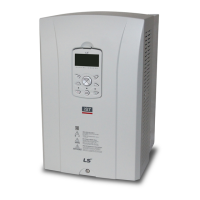Chapter 4 Wiring
4-8
4.1.4 Wiring precaution
1) The internal circuits of the inverter will be damaged if the incoming power is connected
and applied to output terminals (U, V, W).
2) Use ring terminals with insulated caps when wiring the input power and motor wiring.
3) Do not leave wire fragments inside the inverter. Wire fragments can cause faults,
breakdowns, and malfunctions.
4) For input and output, use wires with sufficient size to ensure voltage drop of less than
2%. Motor torque may drop of operating at low frequencies and a long wire run
between inverter and motor.
5) The cable length between inverter and motor should be less than 150m (492ft). Due to
increased leakage capacitance between cables, overcurrent protective feature may
operate or equipment connected to the output side may malfunction. [But for products
of less than 3.7kW, the cable length should be less than 50m (164ft).]
6) The main circuit of the inverter contains high frequency noise, and can hinder
communication equipment near the inverter. To reduce noise, install line noise filters
on the input side of the inverter.
7) Do not use power factor capacitor, surge killers, or RFI filters on the output side of the
inverter. Doing so may damage these components.
8) Always check whether the LCD and the charge lamp for the power terminal are OFF
before wiring terminals. The charge capacitor may hold high-voltage even after the
power is disconnected. Use caution to prevent the possibility of personal injury.
9) Do not connect with MC at output pare of inverter and make MC On/Off during
operation. It can cause the Trip or damage of inverter.
10) When using a DC common with 30~75kW product, please be careful.
30~75kW product provides P1(+) and P2(+) terminal. In the case of DCR type of
product, P1(+) terminal is before reactor and P2(+) terminal is after reactor.
Therefore When using DC Common, you mush use P2(+) and N.
So, inevitablely to use DC Common, before using that, you muse contact with sales
team in advance. Because various matters need to be considered except for wiring.
Similary, when you connected to an external braking unit, you must use P2(+) and N
terminal.
Otherwise, products can be damaged(ex. Using P1(+) and N Terminal)
4.1.5 Grounding
1) The inverter is a high switching device, and leakage current may flow. Ground the
inverter to avoid electrical shock.
2) The ground impedance for 200V class is 100 ohm or less and 400V class 10ohm or less .
3) Connect only to the dedicated ground terminal of the inverter. Do not use the case or
the chassis screw for grounding.
4) As a minimum, grounding wire should meet the specifications listed below. Grounding
wire should be as short as possible and should be connected to the ground point as
near as possible to the inverter.

